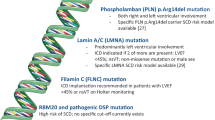Abstract
Left ventricular assist devices (LVAD) are widely used as bridges to cardiac transplantation or for destination therapy. LVAD support may also function as a bridge to ventricular recovery, but a sufficient rate of recovery has not been obtained, even with various adjuvant therapies. Cardiac resynchronization therapy (CRT) is an effective treatment for heart failure, and there is a report of successful weaning off LVAD with CRT. However, some patients with CRT could not improve their cardiac function because of residual dyssynchrony. Herein, we describe a case of a successful bridge to recovery with triple-site pacing for residual dyssynchrony after biventricular pacing. A 34-year-old woman with heart failure due to dilated cardiomyopathy whose condition deteriorated underwent Toyobo LVAD implantation, resulting in improvement of the left ventricular ejection fraction (LVEF) from 12 to 36%. Because of left ventricular dyssynchrony, we performed CRT, but residual dyssynchrony impeded cardiac recovery. We inserted an additional ventricular lead at the right ventricular outlet to achieve triple-site pacing in order to obtain complete synchronization. The LVEF improved to 45%, and the patient was successfully weaned off the LVAD. In LVAD-supported cases of persistent left ventricular dyssynchrony with CRT, implantation of triple-site pacing could potentially accelerate recovery.

Similar content being viewed by others
References
Goldstein D, Oz M, Rose E. Implantable left ventricular assist devices. N Engl J Med. 1998;339:1522–33.
Korfer R, El-Banayosy A, Arusoglu L. Single-center experience with the Thoratec ventricular assist devices. J Thorac Cardiovasc Surg. 2000;119:596–600.
Pennington D, McBride L, Peigh P. Eight years’ experience with bridging to cardiac transplantation. J Thorac Cardiovasc Surg. 1994;107:472–81.
Zaroff JG, Rosengard BR, Armstrong WF, Babcock WD, D’Alessandro A, Dec GW, et al. Consensus conference report: maximizing use of organs recovered from the cadaver donor: cardiac recommendations, March 28–29, 2001, Crystal City, VA. Circulation. 2002;106:836–41.
Frazier OH, Benedict CR, Radovancevic B, Bick RJ, Capek P, Springer WE, et al. Improved left ventricular function after chronic left ventricular unloading. Ann Thorac Surg. 1996;62:675–81.
Wohlschlaegera J, Schmitza KJ, Schmidt C, Schmidt KW, Keulb K, Takedad A, et al. Reverse remodeling following insertion of left ventricular assist devices (LVAD): a review of the morphological and molecular changes. Cardiovasc Res. 2005;68:376–86.
Gojo S, Kyo S, Nishimura S, Komiyama N, Kawai N, Bessho M, et al. Cardiac resurrection after bone-marrow-derived mononuclear cell transplantation during left ventricular assist device support. Ann Thorac Surg. 2007;83:661–2.
Cazeau S, Leclercq C, Lavergne T, Walker S, Varma C, Linde C, et al. Effects of multisite biventricular pacing in patients with heart failure and intraventricular conduction delay. N Engl J Med. 2001;344:873–80.
Nishimura M, Ogiwara M, Ishikawa M, Imanaka K, Okamura N, Kato M, et al. Successful bridge to resynchronization therapy with a left ventricular assist system in a patient with idiopathic dilated cardiomyopathy. J Artif Organs. 2005;8:210–3.
Gelder BMV, Bracke FA, Pilmeyer A, Meijer A. Triple-site ventricular pacing in a biventricular pacing system. PACE. 2001;24:1165–7.
Bulava A, Ansalone G, Ricci R, Giannantoni P, Pignalberi C, Heinc P, et al. Triple-site pacing in patients with biventricular device—incidence of the phenomenon and cardiac resynchronization benefit. J Interv Card Electrophysiol. 2004;10:37–45.
Yoshida K, Sao Y, Yamasaki H, Tanoue K, Murakoshi N, Ishizu T, et al. Effect of triangle ventricular pacing on haemodynamics and dyssynchrony in patients with advanced heart failure: a comparison study with conventional bi-ventricular pacing therapy. Eur Heart J. 2007;28:2610–9.
Leclercq C, Gadler F, Kranig W, Ellery S, Gras D, Lazarus A, et al. A randomized comparison of triple-site versus dual-site ventricular stimulation in patients with congestive heart failure. Eur Heart J. 2008;51:1455–62.
Saito M, Okayama H, Nishimura K, Ogimoto A, Ohtsuka T, Inoue K, et al. Determinants of left ventricular untwisting behaviour in patients with dilated cardiomyopathy: analysis by two-dimensional speckle tracking. Heart. 2009;95:290–6.
Yu CM, Fung JW, Zhang Q, Chan CK, Chan YS, Lin H, et al. Tissue Doppler imaging is superior to strain rate imaging and postsystolic shortening on the prediction of reverse remodeling in both ischemic and nonischemic heart failure after cardiac resynchronization therapy. Circulation. 2004;110:66–73.
Yu CM, Chau E, Sanderson JE, Fan K, Tang MO, Fung WH, et al. Tissue Doppler echocardiographic evidence of reverse remodeling and improved synchronicity by simultaneously delaying regional contraction after biventricular pacing therapy in heart failure. Circulation. 2002;105:438–45.
Lenarczyk R, Kowalski O, Pruszkowska-Skrzep P, Kukulski T, Pluta S, Szulik M, et al. Triple site biventricular pacing in a patient with congestive heart failure and severe mechanical dyssynchrony. J Interv Card Electrophysiol. 2007;18:187–90.
Dandel M, Weng Y, Siniawski H, Potapov E, Lehmkuhl HB, Hetzer R. Long-term results in patients with idiopathic dilated cardiomyopathy after weaning from left ventricular assist devices. Circulation. 2005;112:I-37–45.
Author information
Authors and Affiliations
Corresponding author
Rights and permissions
About this article
Cite this article
Nishimura, T., Kyo, S. Triple-site pacing: a new supported therapy approach for bridge to recovery with a left ventricular assist system in a patient with idiopathic dilated cardiomyopathy. J Artif Organs 13, 54–57 (2010). https://doi.org/10.1007/s10047-010-0494-z
Received:
Accepted:
Published:
Issue Date:
DOI: https://doi.org/10.1007/s10047-010-0494-z




